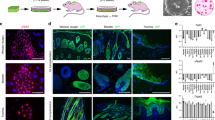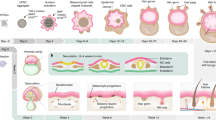Abstract
The hair follicle bulge possesses putative epithelial stem cells. Characterization of these cells has been hampered by the inability to target bulge cells genetically. Here, we use a Keratin1-15 (Krt1-15, also known as K15) promoter to target mouse bulge cells with an inducible Cre recombinase construct or with the gene encoding enhanced green fluorescent protein (EGFP), which allow for lineage analysis and for isolation of the cells. We show that bulge cells in adult mice generate all epithelial cell types within the intact follicle and hair during normal hair follicle cycling. After isolation, adult Krt1-15-EGFP-positive cells reconstituted all components of the cutaneous epithelium and had a higher proliferative potential than Krt1-15-EGFP-negative cells. Genetic profiling of hair follicle stem cells revealed several known and unknown receptors and signaling pathways important for maintaining the stem cell phenotype. Ultimately, these findings provide potential targets for the treatment of hair loss and other disorders of skin and hair.
This is a preview of subscription content, access via your institution
Access options
Subscribe to this journal
Receive 12 print issues and online access
$209.00 per year
only $17.42 per issue
Buy this article
- Purchase on Springer Link
- Instant access to full article PDF
Prices may be subject to local taxes which are calculated during checkout



Similar content being viewed by others
Accession codes
References
Cotsarelis, G., Cheng, S.Z., Dong, G., Sun, T.T. & Lavker, R.M. Existence of slow-cycling limbal epithelial basal cells that can be preferentially stimulated to proliferate: implications on epithelial stem cells. Cell 57, 201–209 (1989).
Tsai, R.J., Li, L.M. & Chen, J.K. Reconstruction of damaged corneas by transplantation of autologous limbal epithelial cells. N. Engl. J. Med. 343, 86–93 (2000).
Bernstein, I.D., Andrews, R.G. & Rowley, S. Isolation of human hematopoietic stem cells. Blood Cells 20, 15–24 (1994).
Paus, R. & Cotsarelis, G. The biology of hair follicles. N. Engl. J. Med. 341, 491–497 (1999).
Cotsarelis, G. & Millar, S.E. Towards a molecular understanding of hair loss and its treatment. Trends in Mol. Med. 7, 293–301 (2001).
Cotsarelis, G., Sun, T.T. & Lavker, R.M. Label-retaining cells reside in the bulge area of pilosebaceous unit: implications for follicular stem cells, hair cycle, and skin carcinogenesis. Cell 61, 1329–1337 (1990).
Lyle, S. et al. The C8/144B monoclonal antibody recognizes cytokeratin 15 and defines the location of human hair follicle stem cells. J. Cell Sci. 111, 3179–3188 (1998).
Oshima, H., Rochat, A., Kedzia, C., Kobayashi, K. & Barrandon, Y. Morphogenesis and renewal of hair follicles from adult multipotent stem cells. Cell 104, 233–245 (2001).
Morris, R.J. & Potten, C.S. Highly persistent label-retaining cells in the hair follicles of mice and their fate following induction of anagen. J. Invest. Dermatol. 112, 470–475 (1999).
Wilson, C. et al. Cells within the bulge region of mouse hair follicle transiently proliferate during early anagen: heterogeneity and functional differences of various hair cycles. Differentiation 55, 127–136 (1994).
Taylor, G., Lehrer, M.S., Jensen, P.J., Sun, T.T. & Lavker, R.M. Involvement of follicular stem cells in forming not only the follicle but also the epidermis. Cell 102, 451–461 (2000).
Tumbar, T. et al. Defining the epithelial stem cell niche in skin. Science 303, 359–363 (2004).
Liu, Y., Lyle, S., Yang, X. & Cotsarelis, G. Keratin 15 promoter targets putative epithelial stem cells in the hair follicle bulge. J. Invest. Dermatol. 121, 963–968 (2003).
Panteleyev, A.A., Jahoda, C.A. & Christiano, A.M. Hair follicle predetermination. J. Cell Sci. 114, 3419–3431 (2001).
Lavker, R.M. et al. Hair follicle stem cells. J. Investig. Dermatol. Symp. Proc. 8, 28–38 (2003).
Berton, T.R. et al. Characterization of an inducible, epidermal-specific knockout system: differential expression of lacZ in different Cre reporter mouse strains. Genesis 26, 160–161 (2000).
Potten, C.S. & Booth, C. Keratinocyte stem cells: a commentary. J. Invest. Dermatol. 119, 888–899 (2002).
Watt, F.M. Stem cell fate and patterning in mammalian epidermis. Curr. Opin. Genet. Dev. 11, 410–417 (2001).
Braun, K.M. et al. Manipulation of stem cell proliferation and lineage commitment: visualisation of label-retaining cells in wholemounts of mouse epidermis. Development 130, 5241–5255 (2003).
Trempus, C.S. et al. Enrichment for living murine keratinocytes from the hair follicle bulge with the cell surface marker CD34. J. Invest. Dermatol. 120, 501–511 (2003).
Kobayashi, K., Rochat, A. & Barrandon, Y. Segregation of keratinocyte colony-forming cells in the bulge of the rat vibrissa. Proc. Natl. Acad. Sci. USA 90, 7391–7395 (1993).
Sutherland, H.J., Lansdorp, P.M., Henkelman, D.H., Eaves, A.C. & Eaves, C.J. Functional characterization of individual human hematopoietic stem cells cultured at limiting dilution on supportive marrow stromal layers. Proc. Natl. Acad. Sci. USA 87, 3584–3588 (1990).
Kamimura, J., Lee, D., Baden, H.P., Brisette, J. & Dotto, G.P. Primary mouse keratinocyte cultures contain hair follicle progenitor cells with multiple differentiation potential. J. Invest. Dermatol. 109, 534–540 (1997).
Weinberg, W.C. et al. Reconstitution of hair follicle development in vivo: determination of follicle formation, hair growth, and hair quality by dermal cells. J. Invest. Dermatol. 100, 229–236 (1993).
Jahoda, C.A., Reynolds, A.J. & Oliver, R.F. Induction of hair growth in ear wounds by cultured dermal papilla cells. J. Invest. Dermatol. 101, 584–590 (1993).
Ivanova, N.B. et al. A stem cell molecular signature. Science 298, 601–604 (2002).
Ramalho-Santos, M., Yoon, S., Matsuzaki, Y., Mulligan, R.C. & Melton, D.A. “Stemness”: transcriptional profiling of embryonic and adult stem cells. Science 298, 597–600 (2002).
Ito, M. & Kizawa, K. Expression of calcium-binding S100 proteins A4 and A6 in regions of the epithelial sac associated with the onset of hair follicle regeneration. J. Invest. Dermatol. 116, 956–963 (2001).
Yuen, T., Wurmbach, E., Pfeffer, R.L., Ebersole, B.J. & Sealfon, S.C. Accuracy and calibration of commercial oligonucleotide and custom cDNA microarrays. Nucleic Acids Res. 30, e48 (2002).
Tseng, H. & Green, H. Association of basonuclin with ability of keratinocytes to multiply and with absence of terminal differentiation. J. Cell Biol. 126, 495–506 (1994).
Petiot, A. et al. A crucial role for Fgfr2-IIIb signalling in epidermal development and hair follicle patterning. Development 130, 5493–5501 (2003).
Huelsken, J., Vogel, R., Erdmann, B., Cotsarelis, G. & Birchmeier, W. beta-Catenin controls hair follicle morphogenesis and stem cell differentiation in the skin. Cell 105, 533–545 (2001).
Van Mater, D., Kolligs, F.T., Dlugosz, A.A. & Fearon, E.R. Transient activation of beta-catenin signaling in cutaneous keratinocytes is sufficient to trigger the active growth phase of the hair cycle in mice. Genes Dev. 17, 1219–1224 (2003).
Meier, N., Dear, T.N. & Boehm, T. Whn and mHa3 are components of the genetic hierarchy controlling hair follicle differentiation. Mech. Dev. 89, 215–221 (1999).
Zheng, Y. et al. Scd1 is expressed in sebaceous glands and is disrupted in the asebia mouse. Nat. Genet. 23, 268–270 (1999).
Kaufman, C.K. et al. GATA-3: an unexpected regulator of cell lineage determination in skin. Genes Dev. 17, 2108–2122 (2003).
Christoph, T. et al. Characteristics of the human hair follicle immune system. Br. J. Dermatol. 142, 862–873 (2000).
Jaworsky, C., Kligman, A.M. & Murphy, G.F. Characterization of inflammatory infiltrates in male pattern alopecia: implications for pathogenesis. Br. J. Dermatol. 127, 239–246 (1992).
Buhl, A.E., Conrad, S.J., Waldon, D.J. & Brunden, M.N. Potassium channel conductance as a control mechanism in hair follicles. J. Invest. Dermatol. 101, 148S–152S (1993).
Kellendonk, C. et al. Regulation of Cre recombinase activity by the synthetic steroid RU 486. Nucleic Acids Res. 24, 1404–1411 (1996).
Paus, R., Stenn, K.S. & Link, R.E. The induction of anagen hair growth in telogen mouse skin by cyclosporine A administration. Lab Invest. 60, 365–369 (1989).
Morris, R.J., Fischer, S.M., Klein-Szanto, A.J. & Slaga, T.J. Subpopulations of primary adult murine epidermal basal cells sedimented on density gradients. Cell Tissue Kinet. 23, 587–602 (1990).
Gilmour, S.K., Teti, K.A., Wu, K.Q. & Morris, R.J. A simple in vivo system for studying epithelialization, hair follicle formation, and invasion using primary epidermal cells from wild-type and transgenic ornithine decarboxylase-overexpressing mouse skin. J. Invest. Dermatol. 117, 1674–1676 (2001).
Li, C. & Wong, W.H. Model-based analysis of oligonucleotide arrays: expression index computation and outlier detection. Proc. Natl. Acad. Sci. USA 98, 31–36 (2001).
Xu, X., Lyle, S., Liu, Y., Solky, B. & Cotsarelis, G. Differential expression of cyclin D1 in the human hair follicle. Am. J. Pathol. 163, 969–978 (2003).
Acknowledgements
We thank Jean Richa for generation of transgenic mice, Hank Pletcher for assistance with FACS, Don Baldwin for microarray analysis, Dorothy Campbell for histological preparations and John Stanley and Peter Sterling for discussion and comments on the manuscript. This work was supported by NIH grants AR46837 to G.C. and CA97957 to R.J.M. and G.C.
Author information
Authors and Affiliations
Corresponding author
Ethics declarations
Competing interests
The authors declare no competing financial interests.
Rights and permissions
About this article
Cite this article
Morris, R., Liu, Y., Marles, L. et al. Capturing and profiling adult hair follicle stem cells. Nat Biotechnol 22, 411–417 (2004). https://doi.org/10.1038/nbt950
Received:
Accepted:
Published:
Issue Date:
DOI: https://doi.org/10.1038/nbt950
This article is cited by
-
Local and systemic mechanisms that control the hair follicle stem cell niche
Nature Reviews Molecular Cell Biology (2024)
-
Using Organoids to Tap Mammary Gland Diversity for Novel Insight
Journal of Mammary Gland Biology and Neoplasia (2024)
-
Dedifferentiation maintains melanocyte stem cells in a dynamic niche
Nature (2023)
-
The biophysical property of the limbal niche maintains stemness through YAP
Cell Death & Differentiation (2023)
-
Carbon Dioxide Fractional Laser Treatment Induces Lgr5+ Stem Cell Activation and Hair Regrowth Through the Canonical Wnt/β-Catenin Pathway
Aesthetic Plastic Surgery (2023)



